Strategies for Promoting Positive Behavior in Healthcare Centers
VerifiedAdded on 2020/06/04
|8
|2143
|44
Report
AI Summary
This report examines strategies for promoting positive behavior in healthcare settings, focusing on restrictive interventions and proactive and reactive approaches. It discusses relevant legislation, such as the Criminal Law of 1967 and the Human Rights Act of 1988, and emphasizes the importance of a child-centered approach when dealing with challenging behaviors. The report details the need for safeguards during restrictive physical interventions, the differences between proactive and reactive strategies, and steps to maintain the dignity and respect of individuals. It also outlines steps to check the well-being of individuals following incidents. The conclusion stresses the importance of staff training and support in creating a safe and supportive environment for both patients and healthcare workers.
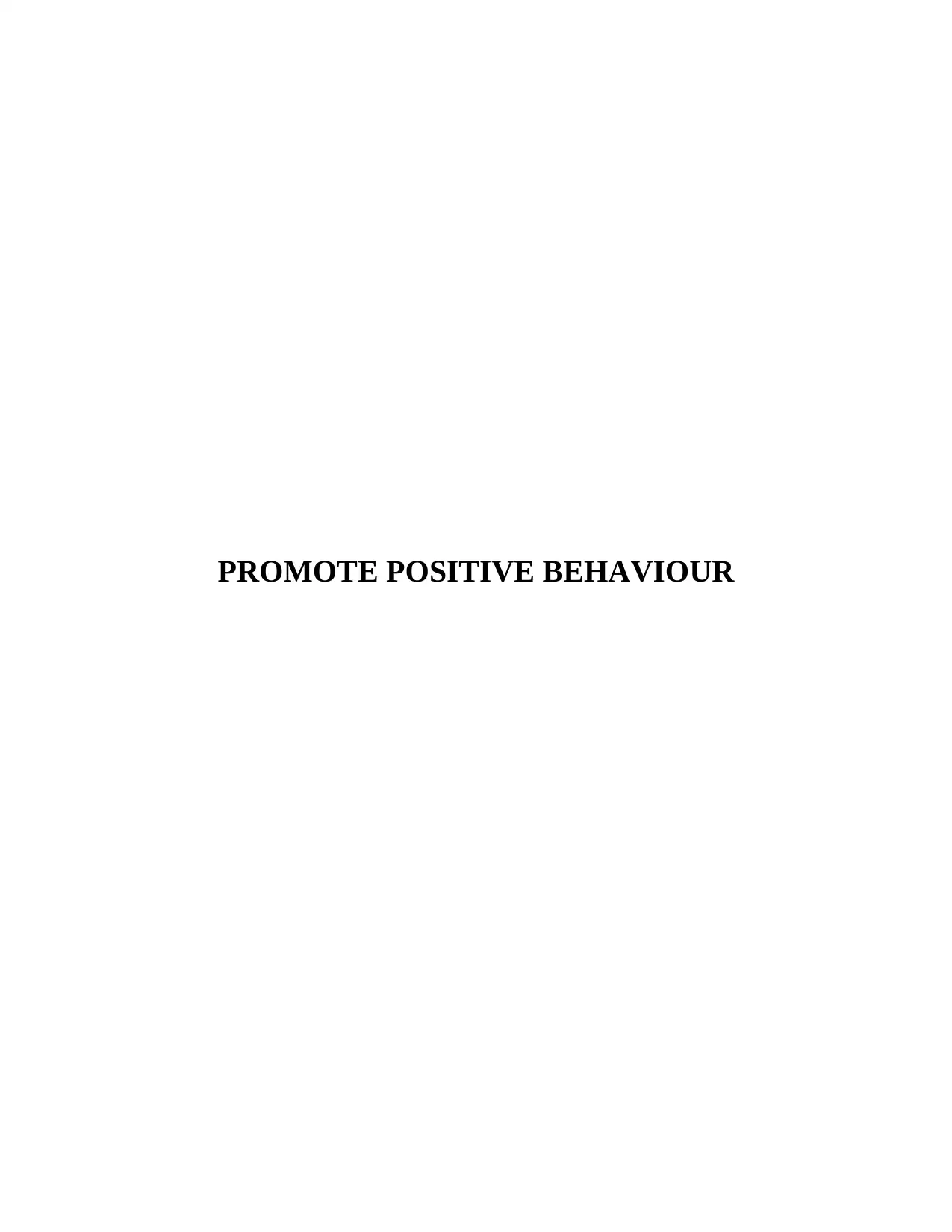
PROMOTE POSITIVE BEHAVIOUR
Paraphrase This Document
Need a fresh take? Get an instant paraphrase of this document with our AI Paraphraser

Table of Contents
INTRODUCTION...........................................................................................................................1
Task..................................................................................................................................................1
P 1. Legislations in relation to restrictive interventions in Health and Social Care centres...1
P 2. Interventions that should be used to promote positive behaviour...................................1
P 3. Explanation on implementing the least restrictive interventions should be used first....2
P 4. Need of safeguards when restrictive physical interventions are used.............................2
P 5. Difference between proactive and reactive strategies.....................................................2
P 6. Importance of maintaining child centred approach when applying proactive strategy...3
P 7. Best practice in positive behaviour.................................................................................3
P 8. Types of challenging behaviours.....................................................................................4
P 9. Steps that can be taken to maintain dignity and respect of individuals when responding to
incidents of challenging behaviour.........................................................................................4
P 10. Steps to be taken to check well-being of an individual following an incident of
challenging behaviour............................................................................................................4
CONCLUSION................................................................................................................................5
REFERENCES................................................................................................................................6
INTRODUCTION...........................................................................................................................1
Task..................................................................................................................................................1
P 1. Legislations in relation to restrictive interventions in Health and Social Care centres...1
P 2. Interventions that should be used to promote positive behaviour...................................1
P 3. Explanation on implementing the least restrictive interventions should be used first....2
P 4. Need of safeguards when restrictive physical interventions are used.............................2
P 5. Difference between proactive and reactive strategies.....................................................2
P 6. Importance of maintaining child centred approach when applying proactive strategy...3
P 7. Best practice in positive behaviour.................................................................................3
P 8. Types of challenging behaviours.....................................................................................4
P 9. Steps that can be taken to maintain dignity and respect of individuals when responding to
incidents of challenging behaviour.........................................................................................4
P 10. Steps to be taken to check well-being of an individual following an incident of
challenging behaviour............................................................................................................4
CONCLUSION................................................................................................................................5
REFERENCES................................................................................................................................6
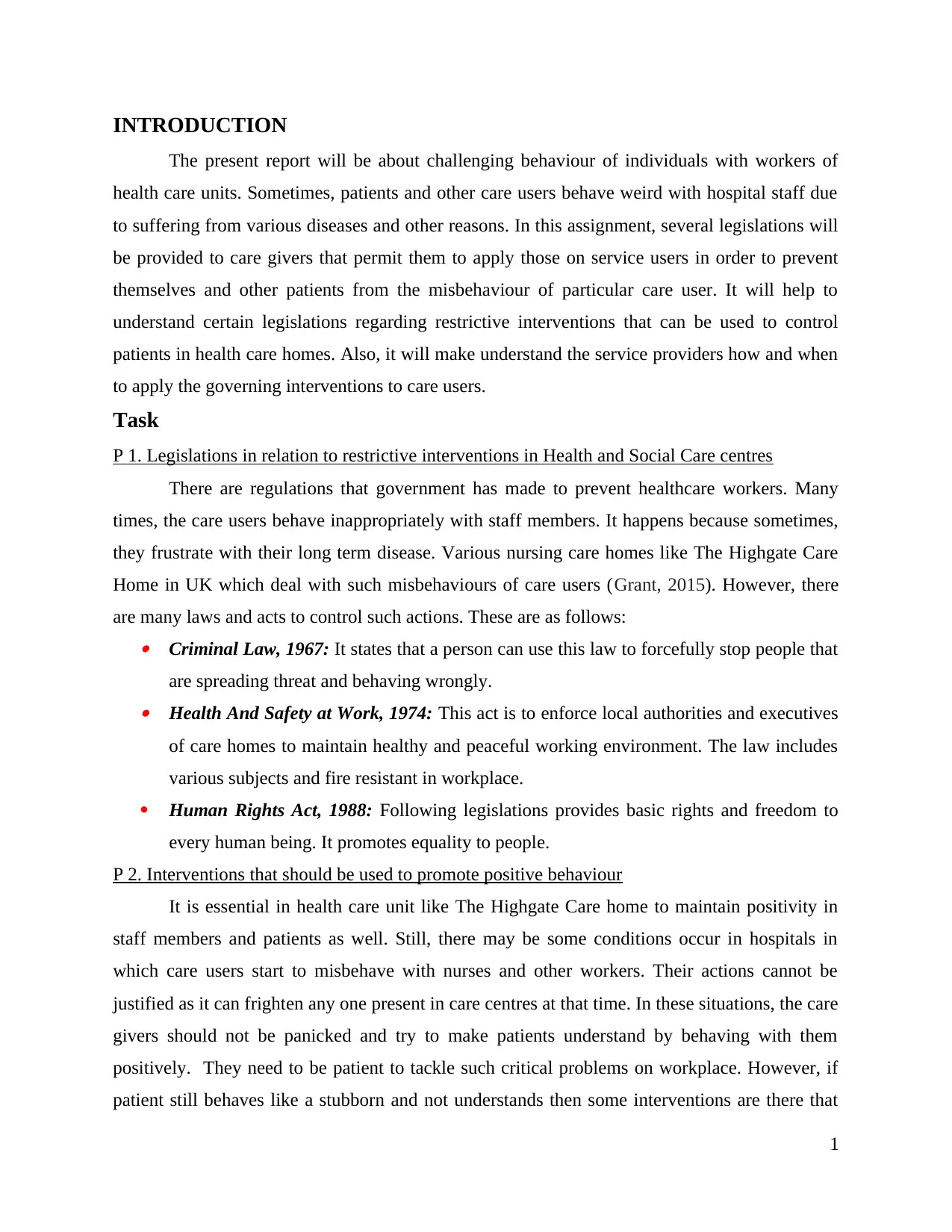
INTRODUCTION
The present report will be about challenging behaviour of individuals with workers of
health care units. Sometimes, patients and other care users behave weird with hospital staff due
to suffering from various diseases and other reasons. In this assignment, several legislations will
be provided to care givers that permit them to apply those on service users in order to prevent
themselves and other patients from the misbehaviour of particular care user. It will help to
understand certain legislations regarding restrictive interventions that can be used to control
patients in health care homes. Also, it will make understand the service providers how and when
to apply the governing interventions to care users.
Task
P 1. Legislations in relation to restrictive interventions in Health and Social Care centres
There are regulations that government has made to prevent healthcare workers. Many
times, the care users behave inappropriately with staff members. It happens because sometimes,
they frustrate with their long term disease. Various nursing care homes like The Highgate Care
Home in UK which deal with such misbehaviours of care users (Grant, 2015). However, there
are many laws and acts to control such actions. These are as follows: Criminal Law, 1967: It states that a person can use this law to forcefully stop people that
are spreading threat and behaving wrongly. Health And Safety at Work, 1974: This act is to enforce local authorities and executives
of care homes to maintain healthy and peaceful working environment. The law includes
various subjects and fire resistant in workplace.
Human Rights Act, 1988: Following legislations provides basic rights and freedom to
every human being. It promotes equality to people.
P 2. Interventions that should be used to promote positive behaviour
It is essential in health care unit like The Highgate Care home to maintain positivity in
staff members and patients as well. Still, there may be some conditions occur in hospitals in
which care users start to misbehave with nurses and other workers. Their actions cannot be
justified as it can frighten any one present in care centres at that time. In these situations, the care
givers should not be panicked and try to make patients understand by behaving with them
positively. They need to be patient to tackle such critical problems on workplace. However, if
patient still behaves like a stubborn and not understands then some interventions are there that
1
The present report will be about challenging behaviour of individuals with workers of
health care units. Sometimes, patients and other care users behave weird with hospital staff due
to suffering from various diseases and other reasons. In this assignment, several legislations will
be provided to care givers that permit them to apply those on service users in order to prevent
themselves and other patients from the misbehaviour of particular care user. It will help to
understand certain legislations regarding restrictive interventions that can be used to control
patients in health care homes. Also, it will make understand the service providers how and when
to apply the governing interventions to care users.
Task
P 1. Legislations in relation to restrictive interventions in Health and Social Care centres
There are regulations that government has made to prevent healthcare workers. Many
times, the care users behave inappropriately with staff members. It happens because sometimes,
they frustrate with their long term disease. Various nursing care homes like The Highgate Care
Home in UK which deal with such misbehaviours of care users (Grant, 2015). However, there
are many laws and acts to control such actions. These are as follows: Criminal Law, 1967: It states that a person can use this law to forcefully stop people that
are spreading threat and behaving wrongly. Health And Safety at Work, 1974: This act is to enforce local authorities and executives
of care homes to maintain healthy and peaceful working environment. The law includes
various subjects and fire resistant in workplace.
Human Rights Act, 1988: Following legislations provides basic rights and freedom to
every human being. It promotes equality to people.
P 2. Interventions that should be used to promote positive behaviour
It is essential in health care unit like The Highgate Care home to maintain positivity in
staff members and patients as well. Still, there may be some conditions occur in hospitals in
which care users start to misbehave with nurses and other workers. Their actions cannot be
justified as it can frighten any one present in care centres at that time. In these situations, the care
givers should not be panicked and try to make patients understand by behaving with them
positively. They need to be patient to tackle such critical problems on workplace. However, if
patient still behaves like a stubborn and not understands then some interventions are there that
1
⊘ This is a preview!⊘
Do you want full access?
Subscribe today to unlock all pages.

Trusted by 1+ million students worldwide
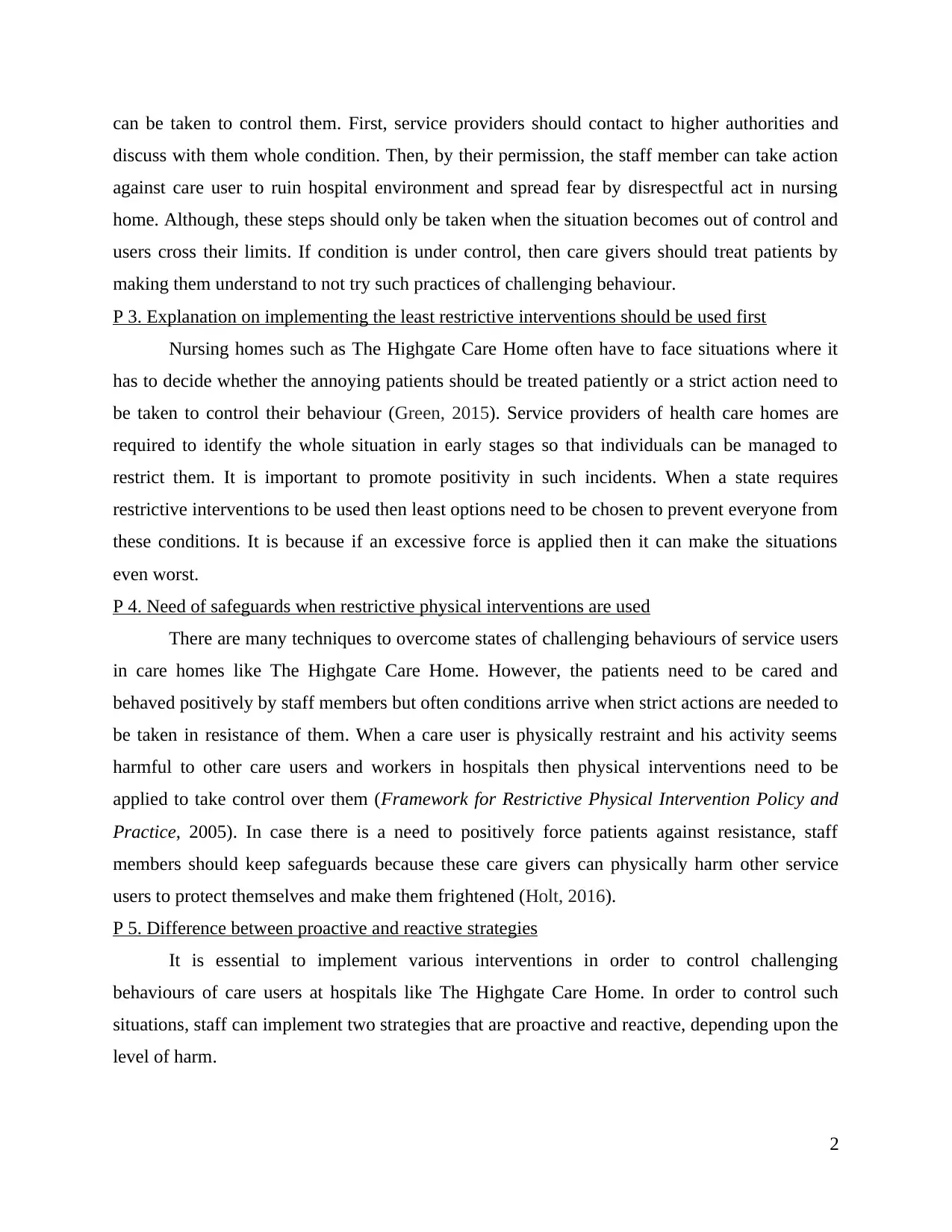
can be taken to control them. First, service providers should contact to higher authorities and
discuss with them whole condition. Then, by their permission, the staff member can take action
against care user to ruin hospital environment and spread fear by disrespectful act in nursing
home. Although, these steps should only be taken when the situation becomes out of control and
users cross their limits. If condition is under control, then care givers should treat patients by
making them understand to not try such practices of challenging behaviour.
P 3. Explanation on implementing the least restrictive interventions should be used first
Nursing homes such as The Highgate Care Home often have to face situations where it
has to decide whether the annoying patients should be treated patiently or a strict action need to
be taken to control their behaviour (Green, 2015). Service providers of health care homes are
required to identify the whole situation in early stages so that individuals can be managed to
restrict them. It is important to promote positivity in such incidents. When a state requires
restrictive interventions to be used then least options need to be chosen to prevent everyone from
these conditions. It is because if an excessive force is applied then it can make the situations
even worst.
P 4. Need of safeguards when restrictive physical interventions are used
There are many techniques to overcome states of challenging behaviours of service users
in care homes like The Highgate Care Home. However, the patients need to be cared and
behaved positively by staff members but often conditions arrive when strict actions are needed to
be taken in resistance of them. When a care user is physically restraint and his activity seems
harmful to other care users and workers in hospitals then physical interventions need to be
applied to take control over them (Framework for Restrictive Physical Intervention Policy and
Practice, 2005). In case there is a need to positively force patients against resistance, staff
members should keep safeguards because these care givers can physically harm other service
users to protect themselves and make them frightened (Holt, 2016).
P 5. Difference between proactive and reactive strategies
It is essential to implement various interventions in order to control challenging
behaviours of care users at hospitals like The Highgate Care Home. In order to control such
situations, staff can implement two strategies that are proactive and reactive, depending upon the
level of harm.
2
discuss with them whole condition. Then, by their permission, the staff member can take action
against care user to ruin hospital environment and spread fear by disrespectful act in nursing
home. Although, these steps should only be taken when the situation becomes out of control and
users cross their limits. If condition is under control, then care givers should treat patients by
making them understand to not try such practices of challenging behaviour.
P 3. Explanation on implementing the least restrictive interventions should be used first
Nursing homes such as The Highgate Care Home often have to face situations where it
has to decide whether the annoying patients should be treated patiently or a strict action need to
be taken to control their behaviour (Green, 2015). Service providers of health care homes are
required to identify the whole situation in early stages so that individuals can be managed to
restrict them. It is important to promote positivity in such incidents. When a state requires
restrictive interventions to be used then least options need to be chosen to prevent everyone from
these conditions. It is because if an excessive force is applied then it can make the situations
even worst.
P 4. Need of safeguards when restrictive physical interventions are used
There are many techniques to overcome states of challenging behaviours of service users
in care homes like The Highgate Care Home. However, the patients need to be cared and
behaved positively by staff members but often conditions arrive when strict actions are needed to
be taken in resistance of them. When a care user is physically restraint and his activity seems
harmful to other care users and workers in hospitals then physical interventions need to be
applied to take control over them (Framework for Restrictive Physical Intervention Policy and
Practice, 2005). In case there is a need to positively force patients against resistance, staff
members should keep safeguards because these care givers can physically harm other service
users to protect themselves and make them frightened (Holt, 2016).
P 5. Difference between proactive and reactive strategies
It is essential to implement various interventions in order to control challenging
behaviours of care users at hospitals like The Highgate Care Home. In order to control such
situations, staff can implement two strategies that are proactive and reactive, depending upon the
level of harm.
2
Paraphrase This Document
Need a fresh take? Get an instant paraphrase of this document with our AI Paraphraser

Proactive approach: This strategy is about applying some rules and regulations in
advance to make understand the individuals how to behave appropriately with staff
members and care users. In addition, it also allows service givers to know everything
about patients and give support and care to them. They need to identify in prior what
triggers patients and make them to behave inappropriately (Moriconi and Bélanger,
2015).
Reactive approach: This approach help staff members to react when the situation comes
where patient's behaviour becomes challenging to handle. The workers need to be skilled
enough to tackle conditions patiently and spread positivity among everyone.
P 6. Importance of maintaining child centred approach when applying proactive strategy
It is important to establish proactive approach in first place to reduce the possibilities of
harm in healthcare units. The Highgate Care Home applies both proactive and reactive strategies
to control harmful situations in care centres. Proactive approach is very crucial when dealing
challenging behaviour of children. So it has to be person or child based when implemented.
These are the reasons to why this approach needs to be child or person centred:
To know any individual.
For respecting and valuing the backgrounds of care users.
To understanding impacts of their environment.
For developing and inspecting their needs and desires.
P 7. Best practice in positive behaviour
In order to promote positive behaviours in care centres such as The Highgate Care Home,
there are various techniques to control challenging behaviour. But in early stages, staff members
should treat them positively and make them understand its negative sides. The best approach to
spread positivity in care homes is identifying the behavioural problems of individuals in initial
stages and trying to ignore them till it is not harmful to others. The care workers need to give full
care and support to such people so that they feel secured and safe in hospitals. In order to
achieve this, top managers and senior staff should conduct training sessions to provide adequate
knowledge to healthcare workers (Previte, Russell‐Bennett and Parkinson, 2015). By this, they
will know how to give love and support to the patients so that there is no need for them to
behave inappropriately with others.
3
advance to make understand the individuals how to behave appropriately with staff
members and care users. In addition, it also allows service givers to know everything
about patients and give support and care to them. They need to identify in prior what
triggers patients and make them to behave inappropriately (Moriconi and Bélanger,
2015).
Reactive approach: This approach help staff members to react when the situation comes
where patient's behaviour becomes challenging to handle. The workers need to be skilled
enough to tackle conditions patiently and spread positivity among everyone.
P 6. Importance of maintaining child centred approach when applying proactive strategy
It is important to establish proactive approach in first place to reduce the possibilities of
harm in healthcare units. The Highgate Care Home applies both proactive and reactive strategies
to control harmful situations in care centres. Proactive approach is very crucial when dealing
challenging behaviour of children. So it has to be person or child based when implemented.
These are the reasons to why this approach needs to be child or person centred:
To know any individual.
For respecting and valuing the backgrounds of care users.
To understanding impacts of their environment.
For developing and inspecting their needs and desires.
P 7. Best practice in positive behaviour
In order to promote positive behaviours in care centres such as The Highgate Care Home,
there are various techniques to control challenging behaviour. But in early stages, staff members
should treat them positively and make them understand its negative sides. The best approach to
spread positivity in care homes is identifying the behavioural problems of individuals in initial
stages and trying to ignore them till it is not harmful to others. The care workers need to give full
care and support to such people so that they feel secured and safe in hospitals. In order to
achieve this, top managers and senior staff should conduct training sessions to provide adequate
knowledge to healthcare workers (Previte, Russell‐Bennett and Parkinson, 2015). By this, they
will know how to give love and support to the patients so that there is no need for them to
behave inappropriately with others.
3
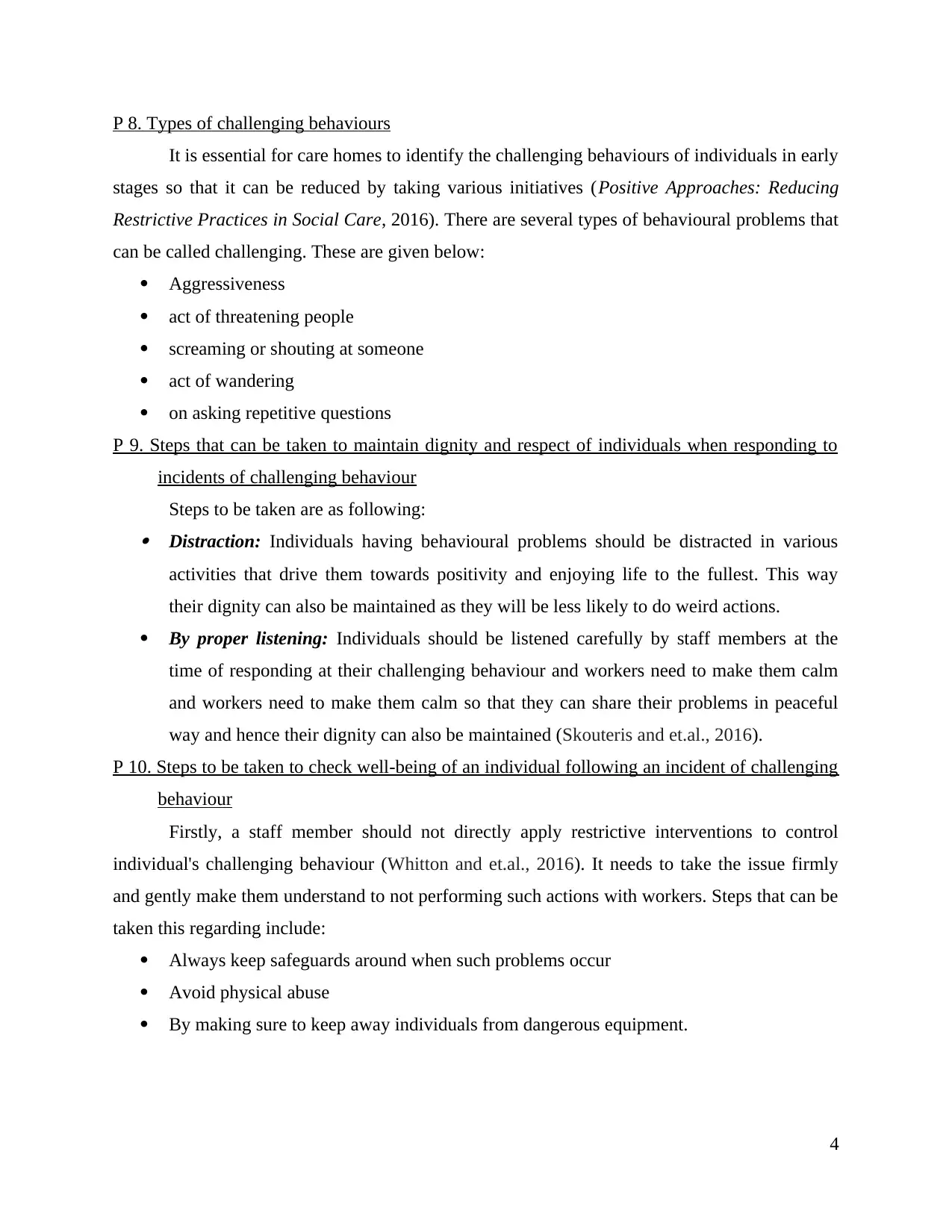
P 8. Types of challenging behaviours
It is essential for care homes to identify the challenging behaviours of individuals in early
stages so that it can be reduced by taking various initiatives (Positive Approaches: Reducing
Restrictive Practices in Social Care, 2016). There are several types of behavioural problems that
can be called challenging. These are given below:
Aggressiveness
act of threatening people
screaming or shouting at someone
act of wandering
on asking repetitive questions
P 9. Steps that can be taken to maintain dignity and respect of individuals when responding to
incidents of challenging behaviour
Steps to be taken are as following: Distraction: Individuals having behavioural problems should be distracted in various
activities that drive them towards positivity and enjoying life to the fullest. This way
their dignity can also be maintained as they will be less likely to do weird actions.
By proper listening: Individuals should be listened carefully by staff members at the
time of responding at their challenging behaviour and workers need to make them calm
and workers need to make them calm so that they can share their problems in peaceful
way and hence their dignity can also be maintained (Skouteris and et.al., 2016).
P 10. Steps to be taken to check well-being of an individual following an incident of challenging
behaviour
Firstly, a staff member should not directly apply restrictive interventions to control
individual's challenging behaviour (Whitton and et.al., 2016). It needs to take the issue firmly
and gently make them understand to not performing such actions with workers. Steps that can be
taken this regarding include:
Always keep safeguards around when such problems occur
Avoid physical abuse
By making sure to keep away individuals from dangerous equipment.
4
It is essential for care homes to identify the challenging behaviours of individuals in early
stages so that it can be reduced by taking various initiatives (Positive Approaches: Reducing
Restrictive Practices in Social Care, 2016). There are several types of behavioural problems that
can be called challenging. These are given below:
Aggressiveness
act of threatening people
screaming or shouting at someone
act of wandering
on asking repetitive questions
P 9. Steps that can be taken to maintain dignity and respect of individuals when responding to
incidents of challenging behaviour
Steps to be taken are as following: Distraction: Individuals having behavioural problems should be distracted in various
activities that drive them towards positivity and enjoying life to the fullest. This way
their dignity can also be maintained as they will be less likely to do weird actions.
By proper listening: Individuals should be listened carefully by staff members at the
time of responding at their challenging behaviour and workers need to make them calm
and workers need to make them calm so that they can share their problems in peaceful
way and hence their dignity can also be maintained (Skouteris and et.al., 2016).
P 10. Steps to be taken to check well-being of an individual following an incident of challenging
behaviour
Firstly, a staff member should not directly apply restrictive interventions to control
individual's challenging behaviour (Whitton and et.al., 2016). It needs to take the issue firmly
and gently make them understand to not performing such actions with workers. Steps that can be
taken this regarding include:
Always keep safeguards around when such problems occur
Avoid physical abuse
By making sure to keep away individuals from dangerous equipment.
4
⊘ This is a preview!⊘
Do you want full access?
Subscribe today to unlock all pages.

Trusted by 1+ million students worldwide
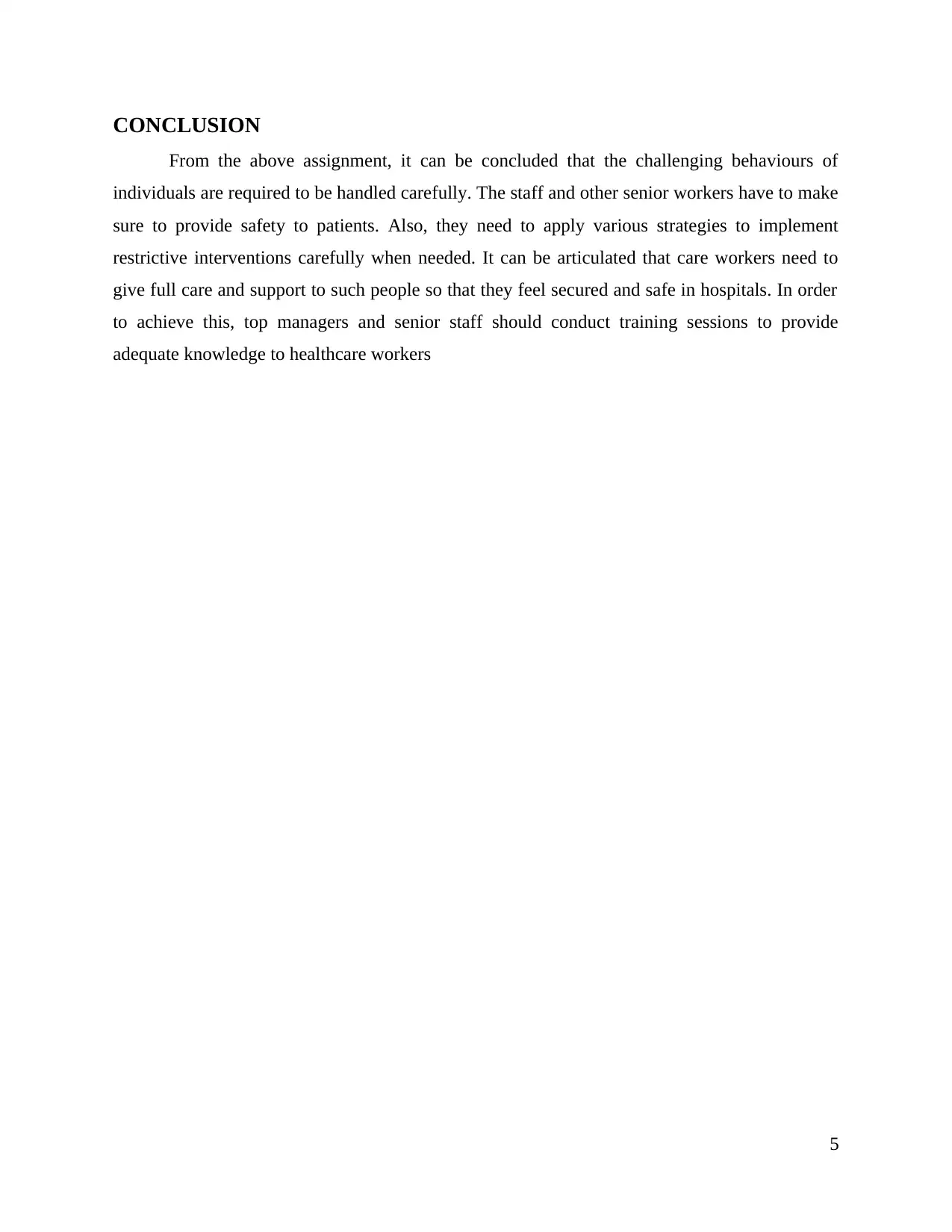
CONCLUSION
From the above assignment, it can be concluded that the challenging behaviours of
individuals are required to be handled carefully. The staff and other senior workers have to make
sure to provide safety to patients. Also, they need to apply various strategies to implement
restrictive interventions carefully when needed. It can be articulated that care workers need to
give full care and support to such people so that they feel secured and safe in hospitals. In order
to achieve this, top managers and senior staff should conduct training sessions to provide
adequate knowledge to healthcare workers
5
From the above assignment, it can be concluded that the challenging behaviours of
individuals are required to be handled carefully. The staff and other senior workers have to make
sure to provide safety to patients. Also, they need to apply various strategies to implement
restrictive interventions carefully when needed. It can be articulated that care workers need to
give full care and support to such people so that they feel secured and safe in hospitals. In order
to achieve this, top managers and senior staff should conduct training sessions to provide
adequate knowledge to healthcare workers
5
Paraphrase This Document
Need a fresh take? Get an instant paraphrase of this document with our AI Paraphraser
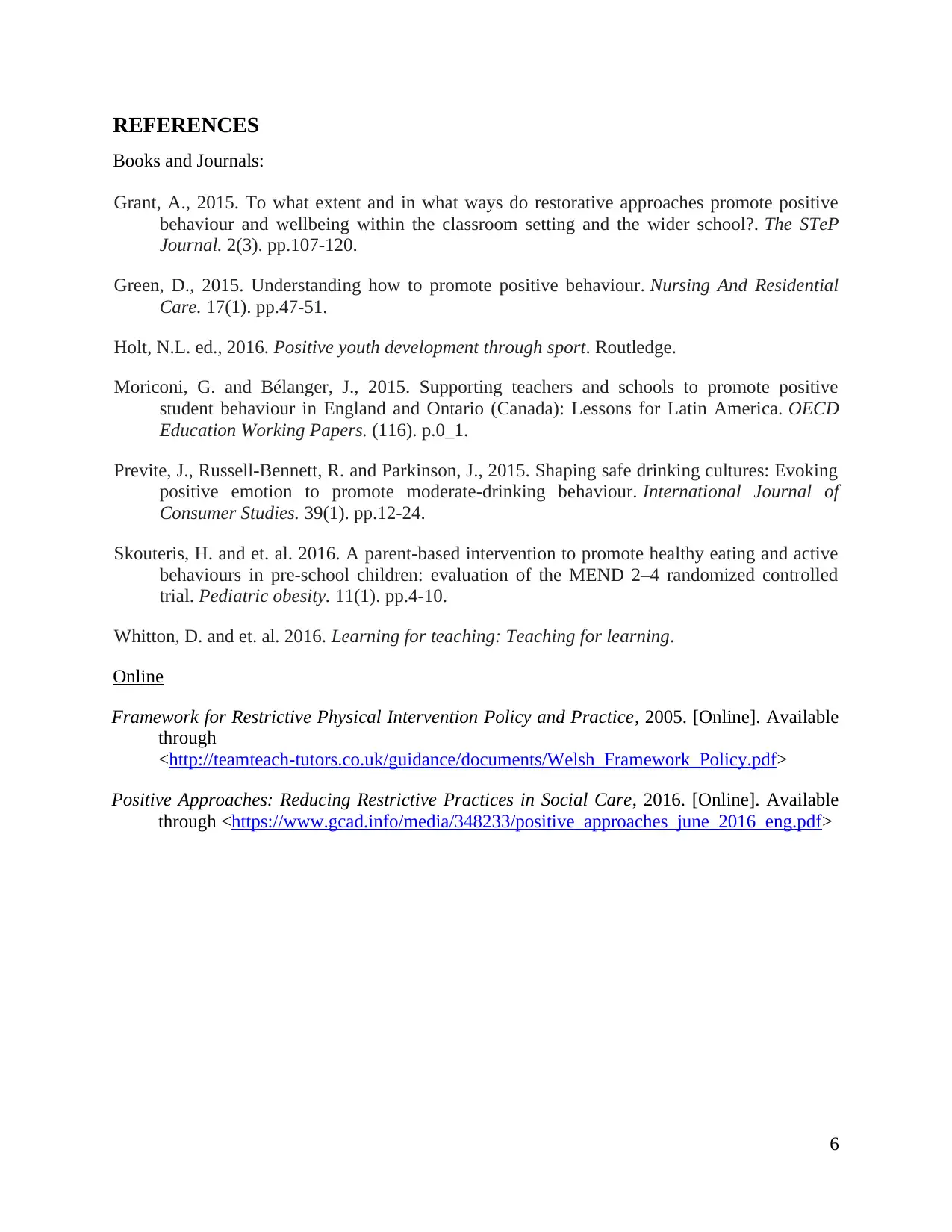
REFERENCES
Books and Journals:
Grant, A., 2015. To what extent and in what ways do restorative approaches promote positive
behaviour and wellbeing within the classroom setting and the wider school?. The STeP
Journal. 2(3). pp.107-120.
Green, D., 2015. Understanding how to promote positive behaviour. Nursing And Residential
Care. 17(1). pp.47-51.
Holt, N.L. ed., 2016. Positive youth development through sport. Routledge.
Moriconi, G. and Bélanger, J., 2015. Supporting teachers and schools to promote positive
student behaviour in England and Ontario (Canada): Lessons for Latin America. OECD
Education Working Papers. (116). p.0_1.
Previte, J., Russell‐Bennett, R. and Parkinson, J., 2015. Shaping safe drinking cultures: Evoking
positive emotion to promote moderate‐drinking behaviour. International Journal of
Consumer Studies. 39(1). pp.12-24.
Skouteris, H. and et. al. 2016. A parent‐based intervention to promote healthy eating and active
behaviours in pre‐school children: evaluation of the MEND 2–4 randomized controlled
trial. Pediatric obesity. 11(1). pp.4-10.
Whitton, D. and et. al. 2016. Learning for teaching: Teaching for learning.
Online
Framework for Restrictive Physical Intervention Policy and Practice, 2005. [Online]. Available
through
<http://teamteach-tutors.co.uk/guidance/documents/Welsh_Framework_Policy.pdf>
Positive Approaches: Reducing Restrictive Practices in Social Care, 2016. [Online]. Available
through <https://www.gcad.info/media/348233/positive_approaches_june_2016_eng.pdf>
6
Books and Journals:
Grant, A., 2015. To what extent and in what ways do restorative approaches promote positive
behaviour and wellbeing within the classroom setting and the wider school?. The STeP
Journal. 2(3). pp.107-120.
Green, D., 2015. Understanding how to promote positive behaviour. Nursing And Residential
Care. 17(1). pp.47-51.
Holt, N.L. ed., 2016. Positive youth development through sport. Routledge.
Moriconi, G. and Bélanger, J., 2015. Supporting teachers and schools to promote positive
student behaviour in England and Ontario (Canada): Lessons for Latin America. OECD
Education Working Papers. (116). p.0_1.
Previte, J., Russell‐Bennett, R. and Parkinson, J., 2015. Shaping safe drinking cultures: Evoking
positive emotion to promote moderate‐drinking behaviour. International Journal of
Consumer Studies. 39(1). pp.12-24.
Skouteris, H. and et. al. 2016. A parent‐based intervention to promote healthy eating and active
behaviours in pre‐school children: evaluation of the MEND 2–4 randomized controlled
trial. Pediatric obesity. 11(1). pp.4-10.
Whitton, D. and et. al. 2016. Learning for teaching: Teaching for learning.
Online
Framework for Restrictive Physical Intervention Policy and Practice, 2005. [Online]. Available
through
<http://teamteach-tutors.co.uk/guidance/documents/Welsh_Framework_Policy.pdf>
Positive Approaches: Reducing Restrictive Practices in Social Care, 2016. [Online]. Available
through <https://www.gcad.info/media/348233/positive_approaches_june_2016_eng.pdf>
6
1 out of 8
Related Documents
Your All-in-One AI-Powered Toolkit for Academic Success.
+13062052269
info@desklib.com
Available 24*7 on WhatsApp / Email
![[object Object]](/_next/static/media/star-bottom.7253800d.svg)
Unlock your academic potential
Copyright © 2020–2025 A2Z Services. All Rights Reserved. Developed and managed by ZUCOL.





